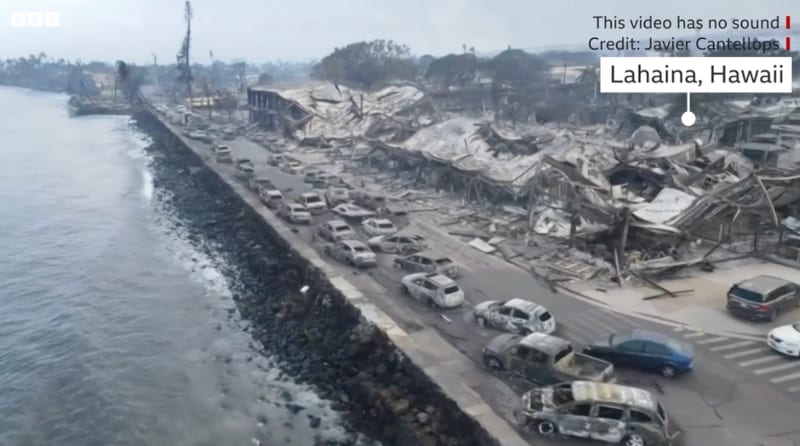Hawaii wildfire rebuild cost est. $5.52bn, with 2,207 structures destroyed

The rebuilding cost of the devastating wildfire in Hawaii that has burned the historic town of Lahaina has been estimated at $5.52 billion, with now 2,207 structures reported to have been destroyed.
Video capture from BBC website.
The Pacific Disaster Center and the Federal Emergency Management Agency released data over the weekend showing that some 2,207 structures are estimated have been destroyed by the Lahaina wildfire in Maui County, Hawaii.
That’s a particularly high percentage of an estimated 2,719 structures that were exposed to the Lahaina Fire, reflecting the severity of this catastrophe event.
The authorities put an estimated capital exposed cost at $5.52 billion, based on the estimated cost to rebuild.
Some 86% of the buildings exposed to the wildfire are residential, with 9% commercial, the data suggests.
It’s a terrible toll, alongside which the death count has been steadily rising, reflecting the severe loss to life and livelihoods from this wildfire event.
Catastrophe risk modelling specialist Karen Clark & Company (KCC) said Friday that, “The total insured loss is expected to be the second largest in Hawaii history, second only to Hurricane Iniki based on today’s property value.”
That seems guaranteed, based on the authorities data on structures destroyed.
The majority would be expected to be fully insured and while the insurance exposure is always largely based on the property damage experienced, there are also costs due to expenses incurred for rehousing and temporary accommodation, as well as contents of structures, damage to cars, and claims for smoke damage, as well.
As a result, it seems highly likely this will be a multi-billion insurance market loss event, with some impact to the reinsurance market as well.
For reference, hurricane Iniki, that struck Hawaii in 1992, is estimated to have caused around $3.1 billion in damages, which is estimated to be equivalent to $6 billion as of 2022 values and currency, and a $1.6 billion insurance market loss at the time of the event.
KCC also said that there were around 3,500 buildings within the fire perimeter in Lahaina.
Meanwhile, Corelogic estimated 3,088 single- and multifamily residential properties with a combined reconstruction value of $1.3 billion within three preliminary wildfire perimeters on Maui, the majority of residential properties being located in Lahaina.
An additional 19 homes are reported to have been destroyed in another wildfire in Upcountry/Kula, with many more damaged.
Reports have emerged over the weekend that suggest there could be an electrical supply link to the wildfires, as claims stated that utility Hawaiian Electric had not implemented safety measures, in shutting down power and power lines when stormy weather and high winds was approaching.
“Hawaiian Electric has a robust wildfire mitigation and grid resiliency program that includes vegetation management, grid hardening investments and regular inspection of our assets,” a statement sent to media company CBS read. “The company has protocols that may be used when high winds are expected, including not enabling the automatic reclosure of circuits that may open during a weather event. This was done before the onset of high winds this week. At this early stage, no cause for the fire has been determined.”
Also this weekend, Whisker Labs, a company that has a fire safety internet-of-things product and network, has stated that its technology had detected faults on power lines in Maui prior to the fires breaking out, citing “dozens of significant utility grid faults were detected by the Ting sensor networks shortly before the first fire reports.”
Whisker Labs also said, “The Ting sensor network continued to detect grid faults in and around Maui, and specifically Lahaina for hours before power was lost. While we cannot say for certain that any utility grid fault was the ignition source for the devastating Maui fires, all fires require an ignition source. Ting network data is definitive regarding utility grid faults and resilience.”
While the cause of the devastating wildfires remain undetermined, the introduction of a potential electrical fault angle as a potential trigger, will raise memories of what happened in California when utility PGE was found to blame for wildfires and the insurance and reinsurance industry secured significant subrogation recoveries.
Which will be a development to watch over the coming weeks, as investigators look into the cause of these terrible fires in Hawaii.
Also read: No significant cat bond market impact from Hawaii wildfires: Plenum.






